What’s Normal
Your Breasts – What’s Normal
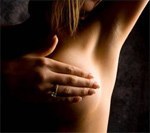 Your breasts will usually start to develop around age 9 to 11, but it’s quite normal for them to start earlier or later than this
Your breasts will usually start to develop around age 9 to 11, but it’s quite normal for them to start earlier or later than this- Everyone’s breasts develop at different rates, so don’t worry if your friends’ breasts are bigger or smaller than yours
- Breasts are usually fully developed by the time you are 17
- Your breasts will change at different times of your life – when you have your period, if you have a baby, and when you get older and your periods stop
Size and Shape
- Breasts come in many different shapes and sizes – no one else will have breasts quite like yours
- Nipples can point up or down, be dark or pale, big or small – and can look different on each breast
- There’s nothing you can do to make your breasts bigger or smaller – creams, pills, massage, exercise or sleeping on your front won’t make any difference
Don’t worry!
All these things are normal, and are nothing to worry about!
- One breast bigger than the other
- One or both nipples turning inwards (inverted)
- Breasts feeling lumpy, smooth, soft or firm
- Hair growing around the nipple
- Bumps on the areola (the darker area around the nipple)
- Tender, sore or lumpy breasts just before your period
- Stretch marks as your breasts develop
All About Bras
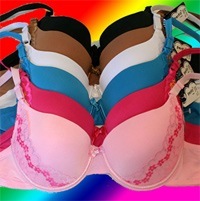 Wearing a bra supports your breasts, which don’t have any muscle
Wearing a bra supports your breasts, which don’t have any muscle- You’ll may to try on lots of different bras to find the best one for you
- Sporty, lacy, padded, underwired – what you wear and when, is up to you
- Most people don’t bother, but it’s fine to sleep in a bra if you want to – just make sure it’s comfortable
- When you exercise wear a sports bra that gives your breasts good support
- Check now and then to make sure your bra still fits and feels comfortable
- If your bra is showing signs of wear and tear it’s time for a new one
Take it back!
A well fitting bra should feel comfortable, make you feel confident and look good. Your bra doesn’t fit properly if
- You have marks or lines on your shoulders, sides, back or breasts when you take it off
- Your breasts bulge out the top, sides or bottom
- The back strap rides up above your shoulderblades
- The centre of the bra sits away from your body
- The underwiring digs in your armpits
- The underwiring sits away from your body
- Your bra cups look wrinkly
- Your bra straps keep slipping down your shoulders
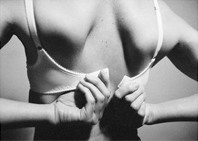 Don’t believe it!
Don’t believe it!
None of these things will give you breast cancer
- Using a deodorant
- Wearing an underwired bra
- Injuring your breast
- Having your nipple pierced
What’s normal?
Breasts: Different Shapes and Sizes
Breasts come in all different sizes and shapes. If you look around you’ll see a huge variety of sizes and shapes of breasts – for example – big, round, flat, pointed, small, pear-shaped and sloping.
Breast size and shape is determined by the genes inherited from our parents. Everyone’s breasts are different, and no one has breasts that are exactly the same as another person’s; you shouldn’t expect your breasts to look the same as anyone else’s.
What can you do?
There’s nothing we can do to make our breasts grow bigger or smaller – or change their shape. But don’t forget that breasts will constantly change while they are developing.
Nipples: Different Shapes, Sizes and Colours
Nipples, as well as breasts, come in all shapes, sizes and colours. They can point up or down, be dark or pale, big or small – and can look different on each breast. Some people have nipples that get hard and stick out (become erect) when they’re cold, or when they’re rubbed. Others have nipples that stick out all the time.
What can you do?
There’s nothing we can do to change the size, shape or colour of our nipples – they are the way they are. If you’re embarrassed about having erect nipples, choose a bra that’s padded at the front or try using skin coloured stick-on nipple covers.
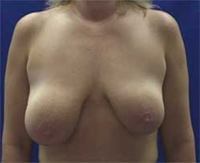 Uneven Breasts
Uneven Breasts
Most women are asymmetrical (10% severely), with the left breast being larger in 62%, especially when the breasts are large.”
It’s common for one breast to be larger than the other and this is perfectly normal. Sometimes one breast may grow quicker than the other, but they will generally even up over time. It’s not unusual for some people to have breasts that are slightly different sizes, or for one to sit higher or lower than the other.
What can you do?
There’s nothing much you can do about uneven breasts. Most differences will even out as you get older. A good bra will help make any differences between breasts less obvious. Surgery (to increase the size of the smaller breast or to reduce the size of the larger breast) can be considered in extreme cases.
Hair Around the Nipples
Some people have a few hairs growing around their nipple and areola. This is completely normal and nothing to worry about.
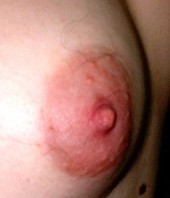 What can you do?
What can you do?
If you’re bothered by hair around the nipple you can cut it off close with small scissors. This is better than plucking or shaving the hair as this may cause infection.
Inverted Nipples
Some people have nipples that are inverted (nipples that are turned inwards). This is quite normal. Inverted nipples can be like that from birth or happen as the breasts are developing. If you’ve always had inverted nipples this is normal for you and nothing to worry about. Sometimes inverted nipples will stick out if they are rubbed, and they may eventually stick out once the breasts have finished growing – or after childbirth and breastfeeding.
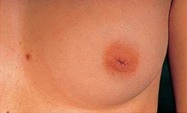
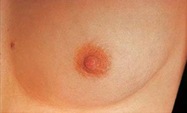
Pimple- like Bumps Around the Nipples
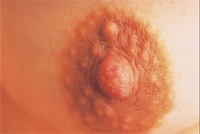 Sebaceous glands, not associated with hair follicles are found in the skin of the areola and open into the ducts just beneath the nipple. They form visible swellings on the areola and can become inflamed. These small bumps on the areola are called Montgomery tubercles and they secrete natural oils. They are normal.
Sebaceous glands, not associated with hair follicles are found in the skin of the areola and open into the ducts just beneath the nipple. They form visible swellings on the areola and can become inflamed. These small bumps on the areola are called Montgomery tubercles and they secrete natural oils. They are normal.
Stretch Marks
Girls who have breasts that develop and grow very quickly may get stretch marks. These are red spoke-like lines that appear on the skin. Lots of girls get them during puberty, and they can also develop during pregnancy. During puberty, stretch marks on the breasts and the rest of the body are very common and completely normal. Over time these stretch marks usually fade to match the colour of the rest of the skin.
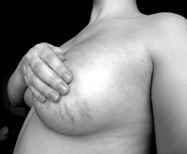
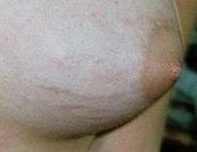
What can you do?
Nothing much can be done to stop stretch marks appearing, especially if your body develops quickly. Keeping the skin well moisturised may be of help. The red marks will fade over time to match the natural colour of the skin.
Tenderness and Pain
You may experience tingling and an aching feeling in your chest when your breasts are developing. After your periods begin, the changing hormones may make the breasts feel tender, painful or sore a week or so just before your period starts. However, this does not happen to everyone.
Smooth or Lumpy Breasts
Breasts may feel either smooth or lumpy – and both are normal. Your breasts may feel lumpy or just different around the time of your period, but they will often settle down again when it’s over. While breasts are growing, lumps may develop and these are nearly always due to normal changes in the breast tissue. Very occasionally lumps are a sign of a benign (harmless) breast condition, which may need to be checked out by a doctor.
The most common benign lump as the breasts are developing is known as a fibroadenoma. A fibroadenoma is a solid lump of tissue, usually around 1 to 3 cm in size, that feels smooth and moves easily under the skin. They are usually painless, though sometimes they can feel tender or even painful. They are very common and don’t usually need any treatment once they have been checked out by a doctor.
What can you do?
If you find a lump in your breast that you are worried about, do go and visit your doctor. Although it’s very unlikely that there’s anything wrong, the doctor will be able to check it out and should put your mind at rest..
Extra Breasts and Nipples
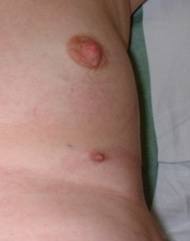 A small number of people have an extra breast or pair of breasts. These are known as accessory breasts and are usually in the lower armpit. They are often present from birth, though sometimes they can appear during puberty. Also, some people have an extra nipple or nipples. These are usually below the breast or above the belly button.
A small number of people have an extra breast or pair of breasts. These are known as accessory breasts and are usually in the lower armpit. They are often present from birth, though sometimes they can appear during puberty. Also, some people have an extra nipple or nipples. These are usually below the breast or above the belly button.
Accessory breasts and extra nipples can often cause anxiety and embarrassment, but they are quite normal. They are not a health concern and don’t need to be removed.
What can you do?
If you have accessory breasts and/or extra nipples you may feel embarrassed and worried about them. When you get your period you may notice normal changes such as a heavy feeling and tenderness in the accessory breast as well as in your natural breasts. If this is upsetting or uncomfortable, do go and talk to your doctor.
Nipple Discharge
Once the breasts have fully developed (usually around the age of 17) you might get some discharge from the nipple. This is perfectly normal and might happen after exercise, or after massaging the breast or nipple. Nipple discharge is generally white in colour, but can range from yellow, to green, to a brown/red colour. It generally appears in small amounts and is nothing to worry about.
What can you do?
Unless there is a large amount of discharge from the nipple this is nothing to worry about – though of course you can visit your doctor if you have any concerns.
Excessive Growth
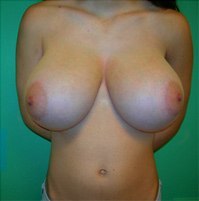 A small number of girls experience excessive growth of breast tissue during development where the breasts grow large and out of proportion to the rest of the body. This is known as breast hypertrophy. It’s not known what causes this, but it’s thought that it may be due to increased sensitivity to hormones. Girls with breast hypertrophy often feel embarrassed and it can also cause physical symptoms such as backache.
A small number of girls experience excessive growth of breast tissue during development where the breasts grow large and out of proportion to the rest of the body. This is known as breast hypertrophy. It’s not known what causes this, but it’s thought that it may be due to increased sensitivity to hormones. Girls with breast hypertrophy often feel embarrassed and it can also cause physical symptoms such as backache.
What can you do?
Dieting and losing weight won’t help reduce the size of the breasts if you have breast hypertrophy. Surgery is really the only option to reduce the size of the breasts.
Know your Breasts
It’s good for you to get to know and love your breasts before, during and after they develop. If you get to know the way your breasts and body normally looks and feels, you’ll know when something changes. So if you usually get lumpy breasts before your period this is nothing to worry about – it is normal for you.
Finding a lump in your breast doesn’t mean you have breast cancer
In fact 9 out of 10 breast lumps are not cancer. Many people will experience lumpy breasts just before a period. This is a normal response to changing hormones and often the lump disappears after the period. If the lump doesn’t go away, however, it’s important to get it checked out by a doctor. Put your mind at rest and don’t be afraid that you’re wasting her/his time.
Breast cancer can affect women with small breasts Breast cancer can affect women with small breasts, medium breasts, large breasts – any size breasts. Breast size is irrelevant.
What bras are for
The main purpose of wearing a bra is to give support to the breasts. Breasts are mainly made up of fatty tissue and don’t contain any muscle. They are supported naturally by the ligaments and muscles behind, but wearing a bra gives them extra support and a defined shape. As you get older a bra can also help stop the breasts from drooping.
It’s a personal choice whether or not to wear a bra when your breasts are developing. It’s often a good idea to wear a bra for support when playing sports or exercising. Most people don’t wear a bra at night, but sleeping in a bra won’t do any harm or stop the breasts developing.
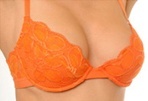

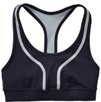
Different size Bras
Just as breasts come in a variety of sizes and shapes, so do bras. Bras come in different back sizes and different cup sizes, ranging from 28 to 46, AA to JJ. The back size is how the bra fits round your back and the cup size is the size of the cup that holds the breast. Most bras also have straps that can be adjusted to give a better fit.
Buying a Bra
There are lots of shops that sell bras, so there are many different places to choose from when buying a bra. If you’re choosing a bra for the first time or if you want to see what’s available you may want to go to a department store and have a look at the many different styles and sizes of bras on sale.
Many department stores also have trained bra fitters who can help you find a bra that fits you properly. A bra fitter will often measure you over your clothes to get a general idea of your back and cup size. This is only a guide as bras will vary in size due to different makes and styles. To find the right bra you’ll have to try on lots of different bras to see which are the most comfortable size and style.
How to find a well fitting Bra
Just like when you buy shoes, you need to try on a bra before you buy it so you know it fits properly. Because bra sizes vary a lot depending on the style, make and material, you may need to try on quite a few before you find one that’s just right.
A bra fits well if
- It’s not too tight or too loose
- Your breasts fill the cup of the bra without bulging over the top or out the sides
- The strap at the back doesn’t cut in
- The shoulder straps don’t carry the full weight of your breasts, stay in place when you lift your arms above your head, and fit closely to your body without cutting in
- The strap round the back and the front underband lie close to your body and are at the same level at the front and back
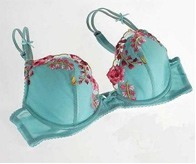 With an underwired bra, the underwire lies flat against your body and supports the underneath and sides of your breast without digging in or gaping
With an underwired bra, the underwire lies flat against your body and supports the underneath and sides of your breast without digging in or gaping
If a bra doesn’t feel right, the best thing is to try another one. Try on different makes and slightly different sizes – just because a bra fits in one style, this doesn’t mean it will fit in another.
When to get a new bra
Your breasts are constantly changing while they are developing, and even when they are fully developed they may still change – and so will your bra size. If a bra doesn’t fit as well as it did – maybe because you’ve gained or lost weight or the bra is slightly worse for wear – it’s probably time to go and buy a new one. Don’t forget that trying on a bra is the only way to find one that fits comfortably.
Frequently Asked Questions
Here are just a few examples of some of the most commonly asked questions from younger women about breasts and breast cancer.
What does or doesn’t increase my risk of breast cancer?
Some newspapers often have stories about different things increasing the risk of getting breast cancer. But when you look at these stories more closely, they are often just trying to grab the attention with a shocking headline and the risk itself – if proved at all – is very small.
Although there is lots of research on breast cancer, we still don’t know what causes it. There doesn’t seem to be one single cause, but rather a combination of lots of different things. We do know some things that increase the risk of getting breast cancer, but not all of them – and we still don’t know why some people get it and some don’t.
…smoking?
No, although smoking is the biggest single cause of cancer in the world it does not appear to significantly affect the risk of breast cancer. But smoking is definitely not a good idea – it’s known to increase the risk not only of lung cancer but also of cancer of the bladder, cervix, kidney, voice box (larynx), mouth, food pipe (oesophagus), pancreas, stomach and some types of leukaemia. Smoking has also been proven to increase the risk of heart disease and some respiratory conditions.
…using deodorant?
No. A hoax email first linked antiperspirants and deodorants to breast cancer. It claimed that deodorants stop the body from sweating out toxins and that these toxins build up in the lymph glands under the armpit and cause breast cancer.
Our bodies have several ways of getting rid of toxins, and while sweating is one of them it does not involve the lymph glands. There has been research done on this subject, which did not find any convincing evidence that antiperspirants or deodorants cause breast cancer.
…wearing an underwired bra?
It’s been suggested that underwired bras constrict the body’s lymph glands, leading to breast cancer. This is not true. A poorly fitting bra may lead to discomfort and pain, but will not increase the risk of developing breast cancer.
…injuring my breast?
An injury such as falling or being hit in the chest will not increase breast cancer risk. It may cause bruising and swelling to the breast. Sometimes this may lead to a benign (non-cancerous) lump known as fat necrosis. Fat necrosis occurs when the fatty breast tissue swells and becomes tender, and as the body naturally repairs the damaged breast tissue scar tissue could form in its place.
…having my nipple pierced?
Nipple piercing will not increase the risk of breast cancer. But it may increase the risk of infection, and breastfeeding later in life may be difficult if the milk ducts are damaged.
…drinking alcohol?
Yes – drinking more than the recommended daily amount (two units for women and three units for men) does increase the risk of developing breast cancer and can contribute to many heart conditions.
Girls who are old enough to drink alcohol need to be careful – many alcoholic drinks contain more than one unit and it’s easy for people to drink more than they mean to.
…taking the contraceptive pill?
A small number of studies have suggested that taking the oral contraceptive pill for a long time may slightly increase the risk of developing breast cancer later in life. However, after stopping taking the pill the risk goes back to normal after 10 years. Recently a large study showed there was no increased risk of developing breast cancer because of taking the pill.
Breast cancer is rare in younger women, for whom taking the pill is still an effective way of preventing pregnancy. The majority of women who take it will not develop breast cancer.
…eating a healthy diet?
No – eating a healthy diet can actually reduce the risk of getting cancer later in life. It can also protect against heart disease, high blood pressure, strokes and diabetes. But those who don’t eat a healthy diet and are very overweight (obese), have an increased risk of getting breast cancer as they get older.
…sunbathing?
No – sunbathing topless will not cause breast cancer. But because the skin on the breast is delicate it’s more likely to get burnt than other areas of the body. Also, too much exposure to ultraviolet (UV) rays in sunlight and from sun beds can cause skin cancer.
To reduce this risk always limit time in the sun, use a sunscreen with a sun protection factor (SPF) of at least 15, be careful never to burn and cover up with a hat, shirt and sunglasses.











